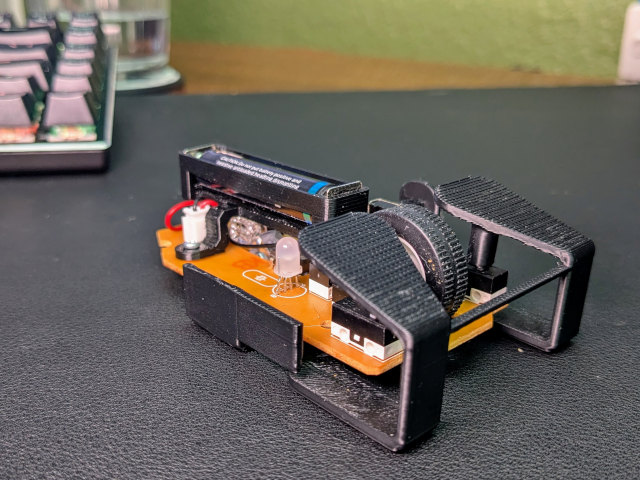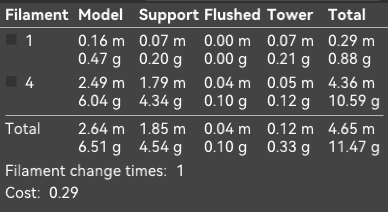This is going to be a short post, because I don’t have a lot to say. I am sure you have been seeing the hubbub lately about how you can print ABS on top of a layer of PLA while keeping the bed temperature way down at 60C. I am mostly just here to tell you that it works, and it works extremely well!
I have been digging my own rabbit hole the last couple of weeks. I discovered a superlight skeletal mouse shell replacement for a fake Logitech G304 mouse that cuts the weight from around 90 grams to 45 grams.

I modified the design a bit to make it more comfortable, then I removed some parts to drop a few grams. That wasn’t light enough for me, so I started tweaking top layers, bottom layers, and perimeters to shave even more weight. I knew the next step was to print in ABS to save another 2 or 3 grams.
The trouble is that my dedicated ABS printer is my Sovol SV06. It is set up with a 0.6-mm nozzle, so it tends to lay down more plastic than necessary for spindly parts. Even with tweaks that was going to wipe out all my savings from the switch to the lighter ABS filament.
The other problem is that the Sovol doesn’t dial in flow rate automatically like my Bambu A1 Mini. I used to print exclusively with ABS when I owned a wooden 3D printer in the olden days, and I absolutely hated removing support material from ABS prints. I knew dialing in the flow rate perfectly would help, and the Bambu would do that for me.
- Can We Compete With The Zeromouse For Under $25?
- Can We Make A 33-Gram Gaming Mouse For Around $12?
- The Bambu A1 – Do I Regret Buying an A1 Mini a Month Ago?
- The Sovol SV06 – Is It Still Worth Buying in 2024?
- Bambu Lab A1 3D Printer
- Bambu Lab A1 Mini 3D Printer
Why can’t the Bambu A1 Mini print ABS?!
You need to get your print bed up to 100C to keep ABS in place. I tried printing ABS with the bed set to its maximum temperature of 80C when I first got the printer, and I had partial success. Very small parts printed fine, but my parts that were around an inch square at the base came loose from the bed after a dozen layers.
You can get around this problem by setting the first layer to print in PLA. That lets you leave the bed at 60C or 65C, and the PLA has no trouble adhering to the bed for the entire print job. In fact, it seems that the PLA first layer does a better job adhering to the bed than ABS will manage with a 100C bed!
You don’t have to have an AMS Lite to make this happen. You can manually swap filament after the first layer.

I wound up reducing the weight of the mouse by almost three grams by switching from PETG to ABS
I don’t even know the correct way to print ABS with the AMS Lite. The printer and slicer didn’t even let me select ABS filament when I tried it last year, and I have been printing my mouse in PETG. I just edited the PETG profile settings that I was already using. I bumped the minimum temperature to 255C, bumped the flow rate up to 19 cubic mm/s, and I just let the machine believe it was printing PETG.
That probably isn’t ideal. The ABS profiles for the Bambu A1 surely have tweaks that do a better job of controlling cooling for bridging, but this definitely got the job done.
I couldn’t believe how easy it was to remove the tree supports!
In the days when I only printed ABS, I avoided supports at all cost. In modern times, supports aren’t so bad with PLA and PETG. Both the slicers and the printers are way better than they used to be, and they’ve improved significantly in just the last couple of years. Supports usually just pop right off of my print on the A1 Mini, while I used to have to attack the same sorts of prints with a pair of pliers on my Prusa MK3S.
I only just realized this week that I may not have printed an ABS part using supports since tree supports were added to Prusa Slicer.
I was amazed. The ABS tree supports almost fell right off my print. It was almost like using a PETG support interface layer on a PLA print. It was a delight!
But my printer’s bed isn’t limited to 80C, is this of any use to me?!
Yes! It seems that printing ABS on a layer of PLA has better adhesion and less chance of warping than printing ABS directly on the bed. This is true with either an open printer or which a chamber.
I imagine there is a point where a heated chamber and a properly hot bed will help keep a tall and complicated ABS part from splitting at the layer lines half way up, but I think I am always going to default to using a layer of PLA on ABS prints whenever the option is available.
Conclusion
I am not breaking any new ground here. JanTec Engineering might have been the first to show us the technique, and Thomas Sanladerer did some really good testing to show us which filament combinations do and don’t stick to each other.
I just figured it might be a good idea to write this blog, raise my hand, and say that this also worked well for me!
ABS is an important filament for me. It is one of the few common 3D-printing materials that survives sitting on the dashboard in the Texas sun. I don’t print ABS a lot, but when I need it, I actually do need it. Being able to print ABS on my Bambu A1 Mini just gives me one less excuse for hanging onto my Sovol SV06!